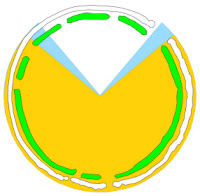STONEHENGE
SIMPLIFIED.
Solving Stonehenge in the
simplest way possible… Graphically.
 Fig SS1: First of all, consider this: Breaking free of the horizon 40-degrees from north
at Stonehenge, this is the maximum area of sky that the moon ever gets to scan,
and does so for several months every 18.6 years. This, the moon’s most
northerly point of rising is called the Major Standstill. The next Major
Standstill will occur in 2006, and if cloud free, should be quite an occasion
for photographers!
Fig SS1: First of all, consider this: Breaking free of the horizon 40-degrees from north
at Stonehenge, this is the maximum area of sky that the moon ever gets to scan,
and does so for several months every 18.6 years. This, the moon’s most
northerly point of rising is called the Major Standstill. The next Major
Standstill will occur in 2006, and if cloud free, should be quite an occasion
for photographers!

Fig SS2: This is the maximum amount of sky that the sun ever manages to scan at
Stonehenge. The sun breaks free 50-degrees clockwise from north and scans a
total of 260-degrees on solstice day every year on the 21st June.
Everyone who visits Stonehenge on solstice morning to see the sunrise looks out
along this 50-degree angle from north.
Fig SS3: But look what
happens when we place the sun-arc on top of the moon-arc - the moon commands a small section of sky (about 10-degrees)
that the sun never gets to visit! - Not
ever!

Fig SS4: Stonehenge started its life as a simple circular-ish
bank and ditch. Bank here is shown green, and the ditch is shown white. The
causeway through the bank and ditch formed an entrance passageway that completely
spans and admits the moon-arc right up to the time of the major standstill. So
the first Stonehenge was dedicated to the moon. Let’s say that again: The
first Stonehenge was dedicated to the moon.




No comments:
Post a Comment